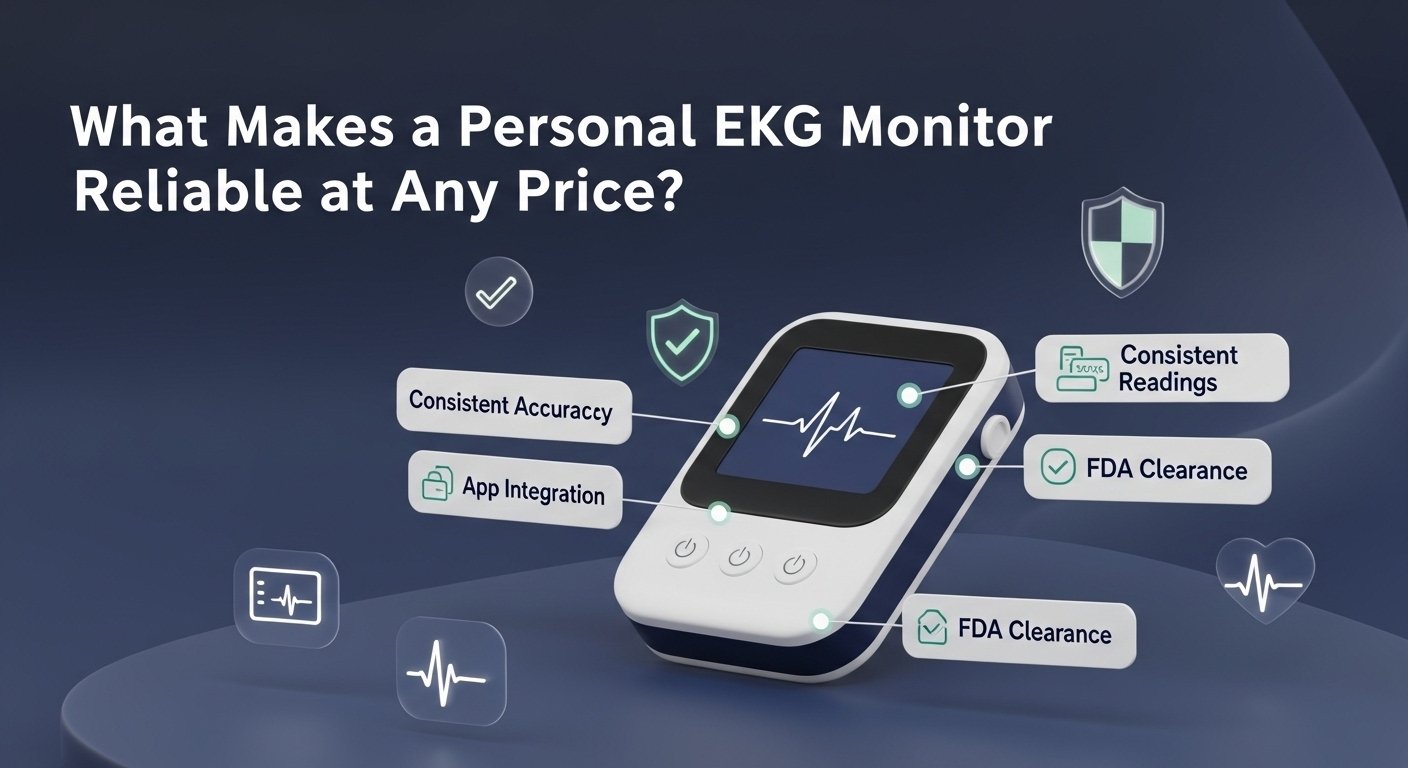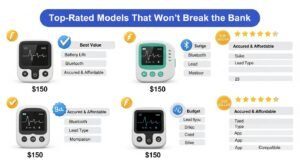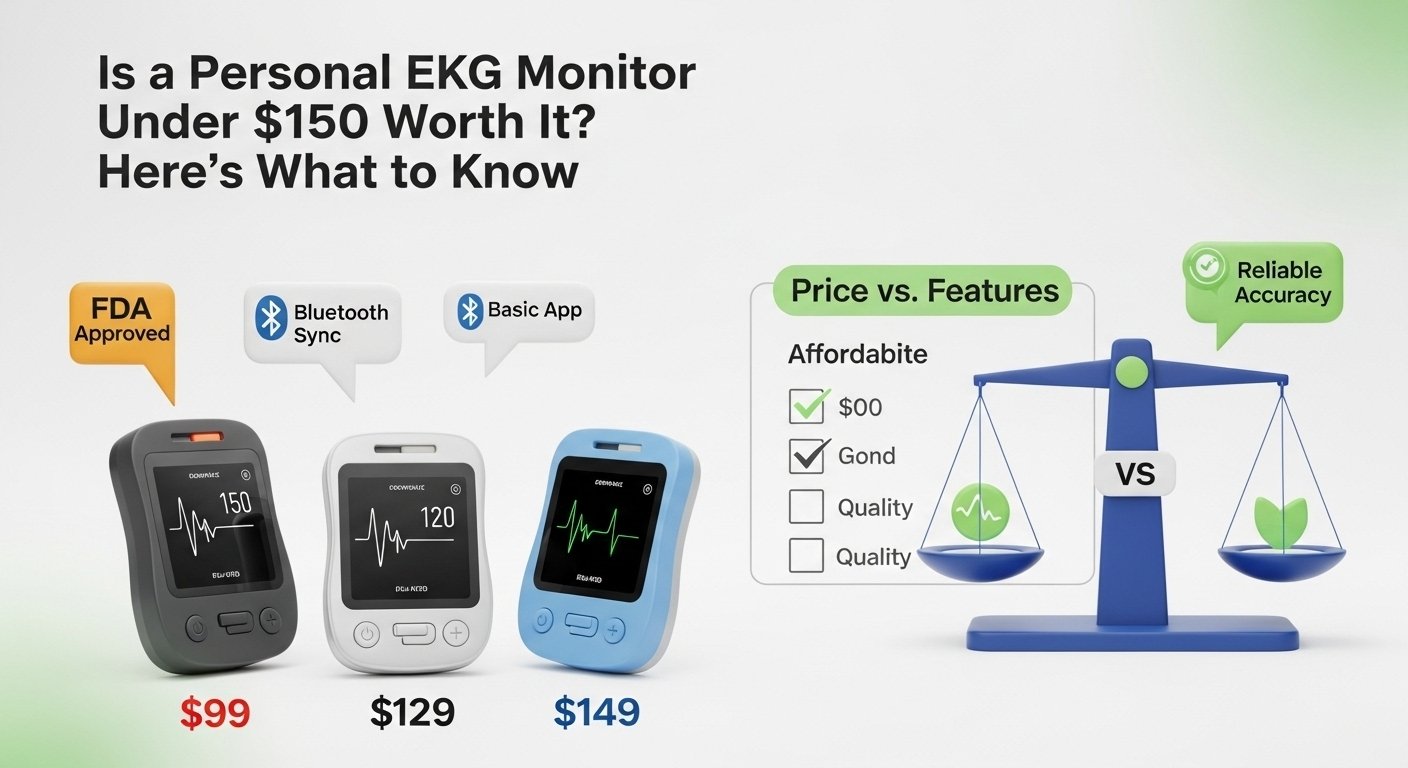Heart health doesn’t wait for your next doctor’s appointment. If you’ve ever experienced palpitations, dizziness, or shortness of breath and had no clue what was happening in the moment, you’re not alone. That’s where a personal EKG monitor steps in. It offers a convenient and increasingly affordable way to get insight into your heart rhythm, without ever stepping foot in a clinic.
As cardiovascular awareness rises, more people are investing in at-home monitoring. And with reliable options now available for under $150, the big question becomes: are they worth it? Let’s break it down piece by piece.
In the next section, we’ll explore what exactly a personal EKG monitor does and why it’s becoming a must-have in modern households.
Understanding What a Personal EKG Monitor Actually Does
A personal EKG monitor is a compact device that records the electrical signals of your heart. Much like the EKG machines used in hospitals, it gives a snapshot of how your heart is functioning in real-time. These devices detect irregular rhythms (arrhythmias), monitor heart rate, and can even help catch early signs of conditions like atrial fibrillation (AFib).
This isn’t about replacing your cardiologist. It’s about empowering you with data between appointments, especially when symptoms come and go. For those managing chronic conditions, such a device can serve as an early-warning system or peace-of-mind provider.
Many users look to these devices for:
- Peace of mind between doctor visits: Being able to self-monitor means you’re not left wondering if symptoms were serious, you have evidence.
- Early detection of irregular heartbeats: Catching an issue before it escalates leads to earlier treatment and fewer surprises.
- Managing chronic heart conditions at home: People with AFib or high blood pressure often need to keep a close eye on their heart. These monitors help them do just that.
Now that you know what these tools do, let’s examine what makes a device trustworthy, especially when you’re buying on a budget.
What Makes a Personal EKG Monitor Reliable at Any Price?
Affordability doesn’t have to mean compromise. The market has grown, and budget-friendly doesn’t equal poor quality. In fact, some personal EKG devices under $150 come with features that rival high-end medical equipment.
To assess reliability, focus on these features:
- FDA clearance or CE certification: This confirms your device meets strict medical standards for safety and performance.
- Bluetooth or app integration: Connecting your readings to a smartphone app gives you access to data logs, trend tracking, and more.
- Storage for past readings: Having access to previous results helps detect patterns or fluctuations in your heart health.
- Clear, easy-to-read data output: Whether you’re looking at a waveform or a digital summary, the ability to understand the result matters.
Knowing these standards makes shopping for the right unit easier. Let’s dive into which features should top your checklist when hunting for a quality EKG monitor under $150.

Features You Should Look For in a Personal EKG Monitor Under $150
Not all budget monitors are created equal. Some pack serious value while others lack even the basics. You need to separate the gimmicks from the essentials.
Look for these features to make your budget count:
- Multi-lead support: Monitors with more leads provide a broader, more detailed picture of your heart’s activity.
- Mobile compatibility: Syncing your device with an app lets you view trends over time, export data, and receive insights instantly.
- Rechargeable battery: Avoid recurring costs and environmental waste by choosing a device that charges via USB.
- Cloud storage: Access your historical data anytime and back it up in case your phone or device gets lost.
Many options under $150 offer one or more of these. Coming up next, we’ll explore the top budget picks users swear by so you can shop smart.
Top-Rated Models That Won’t Break the Bank
While the market is crowded, a few devices shine above the rest in the under-$150 category. These aren’t just affordable, they’re clinically trusted and packed with features.
Here are a few options consumers consistently praise:
- Devices from KardiaMobile and Wellue: These respected brands balance price with performance, offering single or multi-lead options and real-time feedback.
- Units with FDA clearance: Products like these pass the rigorous testing required for medical devices, giving users peace of mind.
- Monitors with intuitive app integration: Real-time data and app alerts make it easier to stay on top of your heart health even while traveling or working.
Choosing from reliable names helps reduce the risk of buying a dud. But even a top-rated personal EKG monitor has pros and cons, especially when you’re shopping in the budget bracket.

The Pros and Cons of Choosing a Budget-Friendly EKG Device
A good EKG monitor doesn’t have to be expensive—but it’s smart to understand the trade-offs. Let’s weigh the benefits and the potential drawbacks.
Pros:
- Lower cost upfront: These devices are ideal for anyone wanting to dip their toes into heart monitoring without financial strain.
- Portability: Lightweight and compact, handheld ECG machine is perfect for daily use or travel. No cords, no fuss.
- On-demand results: Real-time data without booking an appointment can be game-changing for people with unpredictable symptoms.
Cons:
- Limited features: Some budget devices only support single-lead readings or lack storage.
- App connectivity may be basic: You might miss out on advanced tracking or cloud integration depending on the model.
- Shorter warranties or limited customer support: Budget models might save you money initially but could cost you more if something goes wrong.
The key takeaway? Know your needs and limitations. If you’re seeking a Cheap personal EKG device with basic monitoring, many great options exist.
Next, let’s look at real-life examples that show how effective a portable EKG monitor under $150 can be.
Real-Life Scenarios Where a Personal EKG Monitor Proves Invaluable
You don’t need to be a tech guru or healthcare professional to benefit from one of these devices. Many users rely on their personal EKG device in real-world situations that impact their health daily.
Common examples include:
- Catching early signs of AFib at home: This potentially life-threatening condition is often silent. Monitoring regularly increases the chance of early detection.
- Recording symptoms for ER visits: Bringing your readings to the ER saves time and helps doctors make faster decisions.
- Managing stress-related palpitations: Stress and anxiety are common culprits behind irregular rhythms. These devices help validate whether it’s stress or something more.
- Helping elderly parents stay safe: For seniors living alone, being able to check their heart rhythm brings peace of mind to families and caregivers alike.
These everyday moments show the impact even a budget EKG device can make. Still, to get the most value, how you use your monitor matters just as much as which one you buy.
Tips for Getting the Most Out of Your Personal EKG Monitor
Buying a personal ECG monitor is a smart first step. But using it consistently and correctly makes all the difference.
Here’s how to maximize your results:
- Stick to a regular testing schedule: Choose the same time each day—like morning or bedtime—for more reliable trends.
- Minimize movement during readings: Sit still and breathe normally. Even small shifts can interfere with sensor accuracy.
- Limit caffeine beforehand: Stimulants like coffee or energy drinks can skew heart rate readings.
- Store and share data responsibly: Make use of app features that let you export readings or email them directly to your physician.
Consistent use builds a powerful health history. In the next section, we’ll walk through a simple checklist to help you pick the right unit.
Checklist: What to Look for Before Buying a Personal EKG Monitor
Don’t get overwhelmed. Use this quick checklist to evaluate options confidently.
Must-have buying criteria:
- Medical approval or certification: Look for FDA or CE marks that prove your device is medically trustworthy.
- Mobile sync support: Ensure the device pairs easily with your phone or tablet for data access.
- Rechargeable and long battery life: Save on replacement costs and avoid mid-use shutdowns.
- Positive user reviews: Look for consistency in reviews, particularly for reliability, accuracy, and ease of use.
- Supports data sharing: A device that lets you export and email results can strengthen your relationship with your doctor.
With this checklist in hand, you’re ready to choose confidently. But what if you’re still unsure about affordability versus accuracy?
Are Affordable Monitors Really as Accurate as Expensive Ones?
Let’s set the record straight: a personal EKG monitor doesn’t need to cost hundreds to be accurate. Many models under $150 use the same core technology as their higher-end counterparts. The real difference lies in features—not core function.
For example, an Affordable heart monitor may only support a single lead or offer basic app tracking, while a premium model might provide hospital-grade multi-lead analysis. That doesn’t mean budget versions are unreliable—they simply serve different needs.
If you want peace of mind and general monitoring, budget models are more than capable. But if you need deep data for ongoing clinical care, speak with your cardiologist for guidance.
Still unsure whether to invest? Let’s wrap up everything with a quick summary—and a push in the right direction.
Frequently Asked Questions (FAQ)
1. Can a personal EKG monitor detect serious heart issues?
A personal EKG monitor can detect irregular heart rhythms, like AFib, which are common indicators of potential heart issues. However, while these devices are accurate for basic monitoring, they do not replace a professional diagnosis. Always consult a healthcare provider if you notice unusual patterns or symptoms.
2. Are EKG monitors under $150 reliable?
Yes, many personal EKG device models under $150 are both accurate and trustworthy. Look for FDA-cleared or CE-certified options, which follow strict medical device guidelines. These budget-friendly units often provide results that are similar to more expensive counterparts, especially for at-home monitoring.
3. How often should I use my personal EKG monitor?
It depends on your health needs. For general awareness, using it once daily or during symptoms (like palpitations or dizziness) is recommended. If you’re under medical supervision for heart issues, follow your provider’s guidance for how often to use your personal EKG monitor.
4. Can I share EKG results with my doctor?
Absolutely. Most modern EKG devices come with mobile apps that allow you to store and export data. You can send readings via email or share them during appointments to help your doctor make informed decisions.
5. Is it difficult to use a personal EKG monitor at home?
Not at all. Today’s personal EKG devices are designed for ease of use. They typically require you to place your fingers on the sensors or attach a small patch, then wait 30 seconds to 1 minute for a result. Instructions are simple and app interfaces are user-friendly.
6. What’s the difference between a single-lead and multi-lead EKG monitor?
A single-lead EKG monitor captures one view of your heart’s rhythm and is sufficient for basic use. Multi-lead monitors provide a more detailed picture, similar to what doctors use in clinics. If you have a heart condition or need deeper insights, a multi-lead model may be worth considering.
7. Can a budget EKG monitor be used for kids or elderly people?
Yes, but with supervision. While a personal ECG monitor can be used for both children and seniors, always check the age recommendations in the product manual. And consult a physician before regular use, especially if the person has underlying health conditions.
8. Do I need a prescription to buy a personal EKG monitor?
No. Most personal EKG device models available online or in stores are classified as over-the-counter devices, meaning no prescription is necessary. Just ensure you’re buying from a reputable source and look for regulatory approvals like FDA or CE.
9. What happens if the device shows an irregular result?
If your personal ECG monitor displays irregular readings or warnings, stay calm. Record the reading and symptoms, and contact your doctor for next steps. These devices are designed to detect patterns, but only a medical professional can provide a diagnosis and treatment plan.
10. Will a budget monitor still help with stress or anxiety-related heart symptoms?
Yes, many users find comfort in using a personal EKG machine during episodes of stress or anxiety. These devices can reassure you that your heart rhythm is stable, or help identify if further care is needed. They offer clarity in moments when your symptoms may feel overwhelming.
Absolutely! If you know what to look for and use it consistently.
A personal EKG monitor under $150 provides immense value for anyone managing heart health concerns, wanting peace of mind, or simply curious about their heart rhythm trends. Whether you’re tracking occasional symptoms or building daily awareness, these devices offer medical-grade insights at a fraction of the cost.
Now’s the perfect time to invest in your peace of mind. Choose a personal EKG monitor that fits your lifestyle and budget. Don’t wait for your next doctor visit to understand your heart, start tracking today and take your health into your own hands.


